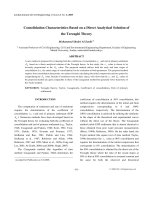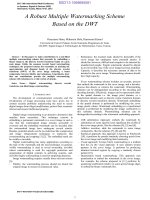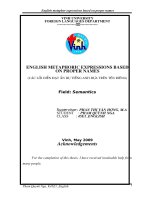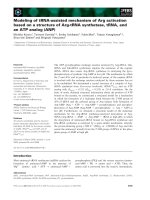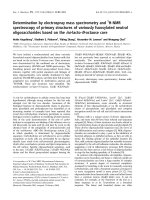host guest composites based on nanoporous materials
Bạn đang xem bản rút gọn của tài liệu. Xem và tải ngay bản đầy đủ của tài liệu tại đây (2.17 MB, 167 trang )
HOST GUEST COMPOSITES BASED ON
NANOPOROUS MATERIALS
By
Xiaoming Zhang
A dissertation submitted to the Graduate Faculty in Chemistry in partial fulfillment of the
requirements for the degree of Doctor of Philosophy, The City University of New York
2006
UMI Number: 3187806
3187806
2006
Copyright 2006 by
Zhang, Xiaoming
UMI Microform
Copyright
All rights reserved. This microform edition is protected against
unauthorized copying under Title 17, United States Code.
ProQuest Information and Learning Company
300 North Zeeb Road
P.O. Box 1346
Ann Arbor, MI 48106-1346
All rights reserved.
by ProQuest Information and Learning Company.
ii
© Copyright 2006
XIAOMING ZHANG
All Rights Reserved.
iii
This manuscript has been read and accepted for the graduate faculty in Chemistry
in satisfaction for the dissertation requirement for the degree of Doctor of Philosophy
Date Chair of Examining Committee: Daniel L. Akins
Date Executive Officer: Gerald Koeppl
Michael C. Drain
James D. Batteas
THE CITY UNIVERSITY OF NEW YORK
iv
ACKNOWLEDGMENTS
In retrospect of the past years, I have always realized that there are many people
who have directed, assisted and supported me during my Ph.D study. Without them I
would never be able to reach this stage in my scientific growth. Although it would be
impossible to name each of them, I would like to express my deep gratitude to all of
them. First, I would like to thank my mentors, Dr. Daniel L. Akins and Dr. James
Batteas, for their tremendous effort in guiding, helping and encouraging me. Their
broad knowledge, insightful thoughts and sparkling ideas have significantly widened
my horizons and inspired my research. Personally, I have also greatly benefited from
their devoted, energetic and enthusiastic manner towards science. I also thank a
member of my candidacy exam and dissertation committee, Dr. Charles M. Drain, for
his time and valuable suggestions.
I would like to thank many of my collaborators and associates. I specially thank
Ms. Sandra Smith for her valuable guidance and assistance when I first started my
research at the City College of the New York. Many thanks are due to Mr. Hanru Zhu,
who has provided generous help in my research, especially in the intramolecular charge
transfer project. Many thanks go to all my labmates, Dr. Hui Yang, Dr. Metin Adyin,
Dr. Yanting Liao, Nathan Stevens, Fleumingue Jean-Mary, Philippe Mercirer,
Shiunchin C. Wang, and Dionne Miller. They have greatly enriched my experience at
the City College and brought me many cherishable memories.
I also want to thank many members of the Department of Chemistry at City
College, including all professors, staff and my fellow graduates, for providing such a
v
joyful study and work environment.
I am grateful to my parents, Mr. Yisheng Zhang and Mrs. Yuefang Wang, and my
sister, Ms. Xiaohui Zhang, for their continuous encouragement and unconditional love
throughout. I shall be indebted to them forever. Finally, I want to thank my wife, Dr.
Haiquan Guo and daughter Michelle. It is their always being there, brightening my
spirit, keeping my heart warm, and making my everyday meaningful and happy.
vi
ABSTRACT
HOST GUEST COMPOSITES BASED ON NANOPOROUS MATERIALS
By Xiaoming Zhang
Advisor: Professor Daniel L. Akins
Porous materials are used as adsorbents, catalysts and catalyst supports owing to
their high surface areas and large pore volumes. This dissertation describes methods of
preparing nanocomposites from mesoporous silicates with uniform channel structures,
as well as some of their applications. Functional groups have been placed selectively
on the internal or external pore surfaces. Organic functionalization of these solids
permits tuning of the surface properties (hydrophilicity, hydrophobicity, binding to
guest molecules), alteration of the surface reactivity, protection of the surface from
attack, and modification of the bulk properties (e.g., mechanical or optical properties)
of the material. Recent applications of modified mesoporous silicates are highlighted,
including catalysis, adsorption of metals, anions, and organics, fixation of biologically
active species, and optical applications.
For these reasons, three different kinds of molecules were successfully
encapsulated within the channels of the mesoporous materials. Novel properties were
found to be result from the confinement within the cavity of the matrices.
DCM is a well-known laser dye that has high fluorescence efficiency and is
photochemically stable. We have been able to observe the dual emission from the by
encapsulation of dye molecules within an alumino-MCM-41. The interaction between
DCM and the internal surface of MCM-41 was found to modify the optical properties
vii
of the confined DCM molecules. The dynamics of DCM in MCM-41 was found to
correspond to a biexponential relaxation with one component of 0.6 ns (57%) and a
very long component of 1.9 ns (43%).
Nanostructural ferric oxide was encapsulated within porous silicate matrices,
resulting in the formation of nanocomposites. The resulting nanocomposites were
characterized by UV–vis, IR, TEM, EPR and X-ray diffraction. EPR measurements
indicate that the various nanocomposites (whose dimensions were controllable by the
pore sizes of the silicate materials), when sufficiently loaded with small Fe
2
O
3
nanoparticles, possess nonzero absorptions at zero applied magnetic field, as well as
significant microwave absorption capacities as a function of applied magnetic field
strength.
The novel polyoxometalate (Eu
8
P
4
W
43
) has been immobilized inside the channels
of MCM-41 mesoporous molecular sieve material by means of the incipient wetness
method. For proper host-guest interaction, amine groups were introduced into the
system as a result of an aminosilylation procedure. A stable and integrated Eu
8
P
4
W
43
polyoxometalate was shown to be formed inside the channels of he modified MCM-41.
The products were characterized by XRD, UV-Vis absorption, emission, Raman
excitation, Raman and
31
P solid-state NMR measurements. A strong
photoluminescence suggests the potential utility of the polyoxometalate as a
luminescent material.
viii
PREFACE
The overall objective of the dissertation is to develop new functional materials,
specifically, nanostructured porous composites, for potential applications in uses of
electro-optical devices, magnetic materials, and drug delivery systems. Two main
considerations are present throughout this dissertation. Firstly, the efforts focus on
constricted syntheses within mesoporous materials of guests (e.g., dye molecules,
polyoxometalates, and Fe
2
O
3
) within solid matrices, for their optical spectroscopic and
other potentially useful properties. Secondly, it is always desirable to have versatile
and controllable synthesis process and products. Of our special interest is the versatile
of the new developed sol-gel pathway. Materials with different morphologies and
composition can be produced and the entire process can be fine tuned. The
organization of the dissertation is as follows.
Chapter 1 is an overview of synthesis and characterization of nanostructural
materials. Based on an introduction of fundamental sol-gel chemistry, nanocomposites
with mesoporous materials are described in detail. Discussions include the template
species, templating mechanisms, reaction conditions and encapsulation methods.
Description of general characterization and testing methods for porous materials is also
provided.
In Chapter 2, we try to provide a summary of the spectroscopic characteristics of
DCM. We employed time dependent density functional theory (TD-DFT) on DCM to
investigate Potential Energy Surfaces (PES) of the ground and excited states in gas
phase. The results suggested that the rotation of the donor group is more favorable
ix
candidate for the intramolecular charge transfer presses of the DCM. We also studied
TICT of DCM encapsulating inside channels of MCM-41. In particular, two
fluorescence bands are observed for DCM occluded within MCM-41. The dual bands
are attributed to emissions from the lowest excited (LE) state and a state created as a
result of intramolecular charge transfer, specifically, the twisted intramolecular charge
transfer (TICT) state. The decay lifetimes for the LE and TICT states are found to be
0.6±0.1 and 1.9±0.1 ns, respectively. The single emissions from the DCM/Y-zeolite
composite and the homogeneous DMSO solution show single exponential decays with
lifetimes of 1.3±0.1 and 2.0±0.1 ns, respectively, both assigned to the TICT state.
In Chapter 3, Nanostructural ferric oxide
was encapsulated within one-dimensional
(1-D) silicate mesoporous molecular materials, resulting in the formation of
nanocomposites. The resulting nanocomposites were characterized by UV-vis, IR,
TEM, EPR and X-ray diffraction. The occluded Fe
2
O
3
nanostructures were found to
evince optical spectra and magnetic properties that were significantly different from
that of bulk Fe
2
O
3
. EPR measurements indicate that the various nanocomposites
(whose dimensions were controllable by the pore sizes of the silicate materials), when
sufficiently loaded with small Fe
2
O
3
nanoparticles, possess nonzero absorptions at zero
applied magnetic field, as well as significant microwave absorption capacities as a
function of applied magnetic field strength. By choosing different matrices, we studied
effects of the particle size and morphology on the magnetic behaviors. It was found
that the pore dimension of the matrix plays a crucial role in the magnetic properties of
the resultant nanocomposite.
Chapter 4 describes the development of a synthetic route to prepare magnetic
x
Fe
2
O
3
nanoparticles via sol-gel process. The study demonstrates the morphological
controllability of the sol-gel templating method. The experimental method, material
characterization and template effect on pore structures are discussed. In this work,
amorphous SiO
2
was selected as host because it has been proven previously a very
effective and biofriendly matrix. With well-defined morphology and nanostructure, the
nanospheres are potentially useful for a variety of applications, such as drug delivery,
bio-sensor and catalyst.
Chapter 5 presents the studies on novel polyoxometalate (POM,
[(Eu
2
PW
10
O
38
)
4
(W
3
O
8
(H
2
O)
2
(OH)
4
]
22-
) nanoparticles dispersion in mesoporous silica
matrices MCM-41 for the perceivable application in functional luminescent materials.
The POM-silica nanocomposites were prepared through a surface-modificated pathway.
The obtained nanocomposites exhibit mesoporosity of the silica framework as well as
the unique size dependent optical properties of the second material phase, i.e., POM
nanoparticles. The products were characterized by XRD, UV-Vis absorption, emission,
Raman excitation, and Raman measurements. Infrared and Raman spectra of the
polyoxometalate/MCM-41 composite systems are interpreted as showing electrostatic
interaction induced spectral shifts. The photoluminescent behavior of the composite at
room temperature indicates a characteristic Eu3+ emission pattern for 5Do–7F
J
transitions. The characteristics of the materials such as composition, morphology,
porosity, and optical properties are discussed.
In Chapter 6, Eu(III) doped MCM-41 and Nb
2
O
5
were studied. Surface valence
transition of Eu(III) and Eu(II) is observed, which is much stronger in Nb
2
O
5
mesoporous matrix. 7F
j
→5L
6
transitions around 394nm is totally shielded for Eu(III)
xi
in MCM-41. But this band can be found in Eu(III)/Nb
2
O
5
composite. For the MCM-
41, which consists of a corner-sharing network of tetrahedally coordinated SiO
4
unites,
only has low vibration quanta, which are not expected to contribute much to
nonradiative deactivation of the excited state of the lanthanide ions. And Eu(III) in
MCM-41, the magnetic dipole transition is more obvious than that of Eu(III) in Nb
2
O
5
.
xii
TABLE OF CONTENTS
ACKNOWLEDGMENTS iv
ABSTRACT vi
PREFACE viii
TABLE OF CONTENTS xii
LIST OF TABLES xvi
LIST OF FIGURES xvii
Chapter 1 Introduction 1
1.1 Chemistry of Advanced Materials 1
1.2 Nanotechnology and Nanomaterials 2
1.3 Properties of Nanostructural Materials 3
1.4 Fabrication and Characterization of nanomaterials 4
1.4.1 Matrix-Mediated Method 5
1.4.1.1 Mesoporous Materials 5
1.4.1.2. Nanocomposites from Mesoporous Materials 7
1.4.2 Characterization Methods 12
1.4.2.1 Transmission Electron Microscopy 12
1.4.2.2 Raman / Infrared Spectroscopy 12
1.4.2.3 X-Ray Diffraction 13
1.4.2.4 Atomic Force Microscopy 13
1.4.2.5 Nitrogen adsorption 14
xiii
Chapter 2: Spectroscopy and Dynamics of DCM in Mesoporous Materials 18
2.1 Introduction 18
2.2 Experimental Section 22
2.2.1 Synthesis of Modified Al Containing MCM-41 22
2.2.2 Formation of DCM/MCM-41 composites 23
2.2.3 Formation of DCM/Y-Zeolite composites 24
2.2.4 Instrumentation 24
2.3 Results 25
2.5 Conclusion 30
Chapter 3 Magnetic Ordering of Ferric Oxide within Mesoporous Materials 41
3.1 Introduction to magnetism 41
3.1.1 Origin of magnetism 41
3.1.2 Magnetization terms 41
3.1.3 Magnetism in materials 42
3.1.4 Theory of ferromagnetism 44
3.2 Background 45
3.3 Experimental 46
3.3.1. Synthesis of mesoporous materials 46
3.3.2. Modification of mesoporous materials 48
3.3.3. Formation of ferric oxide encapsulated within mesoporous materials 48
3.3.4. Instruments 49
3.4 Results and Discussion 49
xiv
Chapter 4: Self-Aligned Magnetic Dipole Moments of Fe
2
O
3
within Sol-Gel Matrix70
4.1 Introduction to Sol-gel Process 70
4.2 Experimental Section 74
4.3 Results and Discussion 75
4.4 Conclusion 79
Chapter 5: Optical Spectra Study of a Novel Polyoxometalate within MCM-41 91
5.1 Introduction to Polyoxometalates 91
5.1.1 Structural Principles of Polyoxometalates 92
5.1.1.1 Basic Structural Units 92
5.1.1.2 Clathrate-like Structures 93
5.1.1.3 Chemical elements taking part in POMs 94
5.1.2 Applications 94
5.2 Scope of the work 95
5.3 Experimental 97
5.4 Results and Discussion 99
5.5 Conclusion 104
Chapter 6 Synthesis and Spectral Studies of Eu
3+
in Mesoporous Sieves 119
Introduction 119
Experimental 121
Results and Discussion: 122
xv
Conclusion 125
REFERENCES 131
References for Chapter One 131
References for Chapter Two 134
References for Chapter Three 137
References for Chapter Four 139
References for Chapter Five 141
References for Chapter Six 144
xvi
LIST OF TABLES
TABLE 3-1: QUALITY FACTOR (Q) FOR THE MICROWAVE CAVITY WHEN
THE DIFFERENT COMPOSITES ARE ENCAPSULATE. THE EXPERIMENTAL
CONDITIONS ARE P = 0.7 MW, MA = 10.5 G, F = 9.49 GHZ, AND THE CELL
IS A 5 MM QUARTZ TUBE. THE APPLIED FIELD IS 99 G.
69
TABLE 4-1: QUALITY FACTOR (Q) OF THE MICROWAVE CAVITY FOR
DIFFERENT COMPOSITES AT AN APPLIED FIELD OF 99 G 80
TABLE 5-1: PORE STRUCTURE PARAMETERS OF (A) MODIFIED MCM-41,
AND (B) EU8P4W43/MCM-41. 118
xvii
LIST OF FIGURES
FIGURE 1-1 % MASS OF SURFACE ATOMS AS A FUNCTION OF
PARTICLE RADIUS.
15
FIGURE 1-2 POSSIBLE MECHANISTIC PATHWAYS FOR THE
FORMATION OF MCM-41: (1) LIQUID-CRYSTAL-PHASE-
INITIATED AND (2) SILICATE-ANION-INITIATED.
16
FIGURE 1-3 A SCHEMATIC DRAWING OF THE SYNTHESIS OF
NANOPARTICLES IN THE MODIFIED CHANNELS OF
MESOPOROUS SILICA.
17
FIGURE 2-1 THE STRUCTURE OF DCM. 31
FIGURE 2-2 THE PREDICTED PESS OF DCM AS FUNCTION OF
ROTATION FROM TRANS TO CIS CONFIGURATION. 32
FIGURE 2-3 PESS OF DCM AS FUNCTION OF ROTATION OF THE
DONOR GROUP FROM 0 TO 180 DEGREE. 33
FIGURE 2-4 GROUND TO EXCITED STATE TRANSITION ELECTRIC
DIPOLE MOMENT AS A FUNCTION OF ROTATION OF
THE ACCEPTOR FROM 0 TO 180 DEGREE. 34
FIGURE 2-5 XRD OF (A) UNCALCINED MCM-41, (B) MODIFIED MCM-
41 AND (C) DCM/MCM-41 COMPOSITE.
35
FIGURE 2-6 UV-VIS SPECTRUM OF (A) 5×10
-5
M DCM DISSOLVED IN
DMSO; DIFFUSE UV-VIS SPECTRUM OF (B) DCM/ MCM-
41 AND (C) DCM/Y-ZEOLITE 36
xviii
FIGURE 2-7 FLUORESCENCE SPECTRA OF (A) 5×10
-5
M DCM
DISSOLVED IN DMSO, (B) DCM/ MCM-41 AND (C)
DCM/Y-ZEOLITE.
37
FIGURE 2-8 FLUORESCENCE OF DCM/MCM-41 COMPOSITE.
EXCITATION WAVELENGTH (A) 360 NM, (B) 440 NM,
AND (C) 480 NM.
38
FIGURE 2-9 LIFETIME DECAY CURVES OF (A) 5×10
-5
M DCM
DISSOLVED IN DMSO; (B) DCM/MCM-41 AND (C)
DCM/Y-ZEOLITE.(λEX=480NM)
39
FIGURE 2-10 DECONVOLUTION OF THE EMISSION BANDS 40
FIGURE 3-1 THE DIFFERENT TYPES OF MAGNETIC BEHAVIOR. 57
FIGURE 3-2 STRUCTURE OF MCM-41 (LEFT) AND MCM-48 (RIGHT). 58
FIGURE 3-3 (A) XRD OF (I) UNCALCINED, (II) FUNCTIONALIZED C8-
MCM-41 AND (III) C8-MCM-41/FE
2
O
3
; (B) XRD OF (I)
UNCALCINED, (II) FUNCTIONALIZED C16-MCM-41 AND
(III) C16-MCM-41/FE
2
O
3
; (C) XRD OF (I) UNCALCINED, (II)
FUNCTIONALIZED SBA-15 AND (III) SBA-15/FE
2
O
3
59
FIGURE 3-4 RAMAN SPECTRA OF (A) C8-MCM-41/FE
2
O
3
; (B) C16-
MCM-41/FE
2
O
3
; AND (C) SBA-15/FE
2
O
3
60
FIGURE 3-5 DR-UV-VIS SPECTRA OF (A) C8-MCM-41/FE
2
O
3
; (B) C16-
MCM-41/FE
2
O
3
; AND (C) SBA-15/FE
2
O
3
61
FIGURE 3-6 INFRARED SPECTRA OF (A) FUNCTIONALIZED C16-
MCM-41 AND (B) C16-MCM-41/FE
2
O
3
62
xix
FIGURE 3-7 TEM OF MICROGRAPHS OF (A) C8-MCM-41/FE
2
O
3
, (B)
C16-MCM-41/FE
2
O
3
AND (C) SBA-15/FE
2
O
3
. THE BOTTOM
INSET IN (C) IS THE DIGITAL DIFFRACTION IMAGE OF
FE
2
O
3
IN SBA-15. (D) SHOWS NANOSTRUCTURAL FE
2
O
3
RECOVERED FROM SBA-15/FE
2
O
3
AFTER HARVESTING
FROM THE SBA-15 MATRIX; MICROGRAPH ACQUIRED
USING A JEOL 100CX TEM OPERATED AT 100KV. 63
FIGURE 3-8 FIRST DERIVATIVE EPR SPECTRA OF A SINGLE SCAN
FROM 99.15 G TO 7099.15 G OF (A) C8-MCM-41/FE
2
O
3,
Y'
H→0
≅ 1060; (B) C16-MCM-41/FE
2
O
3
, Y'
H→0
≅ 810; AND (C)
SBA-15/FE
2
O
3
, Y'
H→0
≅ 502. 64
FIGURE 3-9 TEMPERATURE DEPENDENCE OF THE G-VALUE FOR (A)
C8-MCM-41/FE
2
O
3
(•); (B) C16-MCM-41/FE
2
O
3
(◊); AND (C)
SBA-15/FE
2
O
3
(▲). 65
FIGURE 3-10 TEM OF MCM-48/FE
2
O
3
. SCALE BAR=5 NM 66
FIGURE 3-11 FIRST DERIVATION EPR SPECTRA OF 1 SCAN FROM
99.15 G TO 7099.15 G OF MCM-48/FE
2
O
3
WITH 3 WT%
FE
2
O
3
. 67
FIGURE 3-12 VARIATION WITH TEMPERATURE OF THE RECIPROCAL
OF INTEGRATED INTENSITY OF THE EPR SIGNALS OF
MCM-48/FE
2
O
3
WITH FE
2
O
3
(●). 68
FIGURE 4-1 SCHEMATIC STRUCTURE OF -FE
2
O
3
. PROJECTION
ALONG [0 0 1], •: O AT Z=1/12, 5/12, 3/4; O: O AT Z=1/4,
xx
7/12, 11/12;
: FE AT Z=1/6, 1/3, 2/3, 5/6; : FE AT Z=0, 1/6,
1/2, 2/3;
: FE AT Z=0, 1/3, 1/2, 5/6. 81
FIGURE 4-2 X-RAY DIFFRACTION PATTERNS OF FE
2
O
3
/SIO
2
NANOCOMPOSITES: (A) 8.6 WT%; (B) 16.4 WT%; (C) 33.2
WT%; AND (D) 52.8 WT%.
82
FIGURE 4-3 RAMAN SPECTRUM OF 52.8 WT% FE
2
O
3
/SIO
2
NANOCOMPOSITE.
83
FIGURE 4-4 TEM OF FE
2
O
3
/SIO
2
NANOCOMPOSITES: (A) 8.6 WT%; (B)
16.4 WT%; (C) 33.2 WT%; AND (D) 52.8 WT%.
84
FIGURE 4-5 DR-UV-VIS OF FE
2
O
3
/SIO
2
NANOCOMPOSITES: (A) 8.6
WT%; (B) 16.4 WT%; (C) 33.2 WT%; AND (D) 52.8 WT%.
85
FIGURE 4-6 FT-IR OF FE
2
O
3
/SIO
2
NANOCOMPOSITES, (A) 8.6 WT%; (B)
16.4 WT%; (C) 33.2 WT%; AND (D) 52.8 WT%.
86
FIGURE 4-7 FIRST DERIVATIVE EPR SPECTRA OF SINGLE SCANS
FROM 99.15 G TO 7099.15 G FOR FE
2
O
3
/SIO
2
NANOCOMPOSITES: (A) 8.6 WT%; (B) 16.4 WT%; (C) 33.2
WT%; AND (D) 52.8 WT%.
87
FIGURE 4-8 VARIATION WITH TEMPERATURE OF THE RECIPROCAL
OF THE INTEGRATED INTENSITIES OF EPR SIGNALS
FOR FE
2
O
3
/SIO
2
COMPOSITES OF (A) 8.6 WT% (▲); (B)
16.4 WT% (); (C) 33.2 WT% (•); AND (D) 52.8 WT% (g).
88
FIGURE 4-9 GELATION TEMPERATURE INFLUENCE ON MAGNETIC
PROPERTIES OF FE
2
O
3
, (A) 50
O
C AND (B) 80
O
C 89
xxi
FIGURE 4-10 EPR SIGNAL AMPLITUDE VARIATION WITH
TEMPERATURE OF FE
2
O
3
-SIO
2
, AT (A) 50
O
C, (B) 80
O
C 90
FIGURE 5-1 BALL-AND-STICK AND POLYHEDRAL
REPRESENTATIONS OF THE FUNDAMENTAL UNIT MO6.
NOTE THAT THE M ATOM IS DISPLACED OFF THE
GEOMETRICAL CENTRE OF THE OCTAHEDRON
TOWARDS ONE OF THE OXYGENS, THUS GIVING RISE
TO A DISTORTED C4V UNIT. 106
FIGURE 5-2 POLYHEDRAL VIEW OF THE CLATHRATE-LIKE
STRUCTURE OF KEGGIN ANION. THE EXTERNAL
M
12
O
18
CORE ENCAPSULATES THE INTERNAL UNIT. 107
FIGURE 5-3 BALL-AND STICK REPRESENTATION OF THE KEGIN
HETEROPOLYANION. 108
FIGURE 5-4 BALL AND STICK STRUCTURE OF THE
POLYOXOMETALATE 109
FIGURE 5-5 AFM IMAGE OF THE POLYOXOMETALATE SPIN-
COATED ON MICA
110
FIGURE 5-6 XRD PATTERNS OF (A) MODIFIED MCM-41, AND (B)
EU
8
P
4
W
43
/MCM-41 111
FIGURE 5-7 N
2
ADSORPTION–DESORPTION ISOTHERMS OF (A)
MODIFIED MCM-41, AND (B) EU
8
P
4
W
43
/MCM-41 112
FIGURE 5-8 EXCITATION SPECTRA OF (A) SOLID EU
8
P
4
W
43
AND (B)
COMPOSITE EU
8
P
4
W
43
/MCM-41 113
xxii
FIGURE 5-9 ENERGY LEVEL DIAGRAM OF EU(III) 114
FIGURE 5-10 EMISSION SPECTRA OF (A) SOLID EU
8
P
4
W
43
AND (B)
COMPOSITE EU
8
P
4
W
43
/MCM-41, EXCITED AT 394 NM. 115
FIGURE 5-11 FT-IR SPECTRA OF (A) SOLID EU
8
P
4
W
43
AND (B)
COMPOSITE EU
8
P
4
W
43
/MCM-41 116
FIGURE 5-12 RAMAN SPECTRA OF (A) SOLID EU
8
P
4
W
43
; (B)
COMPOSITE EU
8
P
4
W
43
/MCM-41 117
FIGURE 6-1 XRD PATTERNS OF (A) MCM-41; (B) NB
2
O
5
127
FIGURE 6-2 XPS OF (A) MCM-41/EU
2
O
3
; (B) NB
2
O
5
/EU
2
O
3
; (C)
ER
2
O
3
/EU
2
O
3
128
FIGURE 6-3 RFUV-VIS OF (A)EU
2
O
3
/MCM-41, AND (B)EU
2
O
3
/NB
2
O
5
COMPOSITE 129
FIGURE 6-4 FLUORESCENCE OF (A) EU
2
O
3
/MCM-41, (B) EU
2
O
3
/NB
2
O
5
,
(C) EU(NO
3
)
3
AND (D) BULK EU
2
O
3
130
1
Chapter 1 Introduction
1.1 Chemistry of Advanced Materials
Since the past two decades, there have been major advances in materials chemistry
and the subject is growing rapidly. Some examples include high-temperature cuprate
superconductors (1986), fullerenes (1990), mesoporous silica (1992) and colossal
megnettoresistance (CMR) in manganates (1993), etc. Nowadays, materials chemistry
has become a new branch of modern chemistry related to the development of high
technological materials [1, 2].
The most important motivation of materials chemistry is to understand, to
predict, and to design the properties of materials with respect to chemical
composition, crystal and electronic structures [3]. Today’s materials chemistry
is concerned with the development of new synthesis methods, new ways of
identifying and characterizing materials and of describing their structures.
Although there have been major advances in the synthesis of materials, we are still
far away from a tailor-making of materials with specified structures/properties.
Most of the discoveries of new functional materials still have been made by
chance. Therefore, rational design and synthesis of novel materials have
remained important objectives. The control over the composition is often possible,
but still then there must be a way of producing materials in any required
nanoscopic shape or form. Also, the characterization is a critical ingredient to
progress, because it provides guidance for further research efforts [4].
2
1.2 Nanotechnology and Nanomaterials
Nanotechnology is concerned with the development of novel methods for
the synthesis and characterization of chemical systems within the size range of
about 1 to 100 nm [5]. The interest in nanoscale objects is due to the exhibition
of novel electronic, optical, magnetic, transport, photochemical, electrochemical,
catalytic and mechanical behavior, depending on composition, size, and shape of the
particles. The physical properties of nanoparticles correspond neither to those of the
free atoms or molecules making up the particle nor to those of the bulk solids with
identical chemical composition [6]. It is astonishing that many relevant
phenomena at nanoscale are caused by the tiny size of the organized structure and
by interactions at their predominant and complex interfaces [7]. Once the chemists
are able to gain control over size and shape of the particles, further enhancement of
material properties and device functions will surely be possible. Each change in
both, composition or size can lead to different physical and chemical properties,
providing a large number of new materials [8].
The most important aspect is still the development of new strategies for the
synthesis of nanomaterials, particularly soft chemical routes. But the chemist not
only has to be able to synthesize perfect, i.e., monodispersed and shape-defined
objects having nanometer dimensions, but also he may have to position these
objects in appropriately organized arrays. This may be tackled either by using
lithographic techniques [9] or templating methods (molecular and
supramolecular assembly processes, [10] or deposition inside nanoporous host
materials [11]). However, the templating methods may become the most

